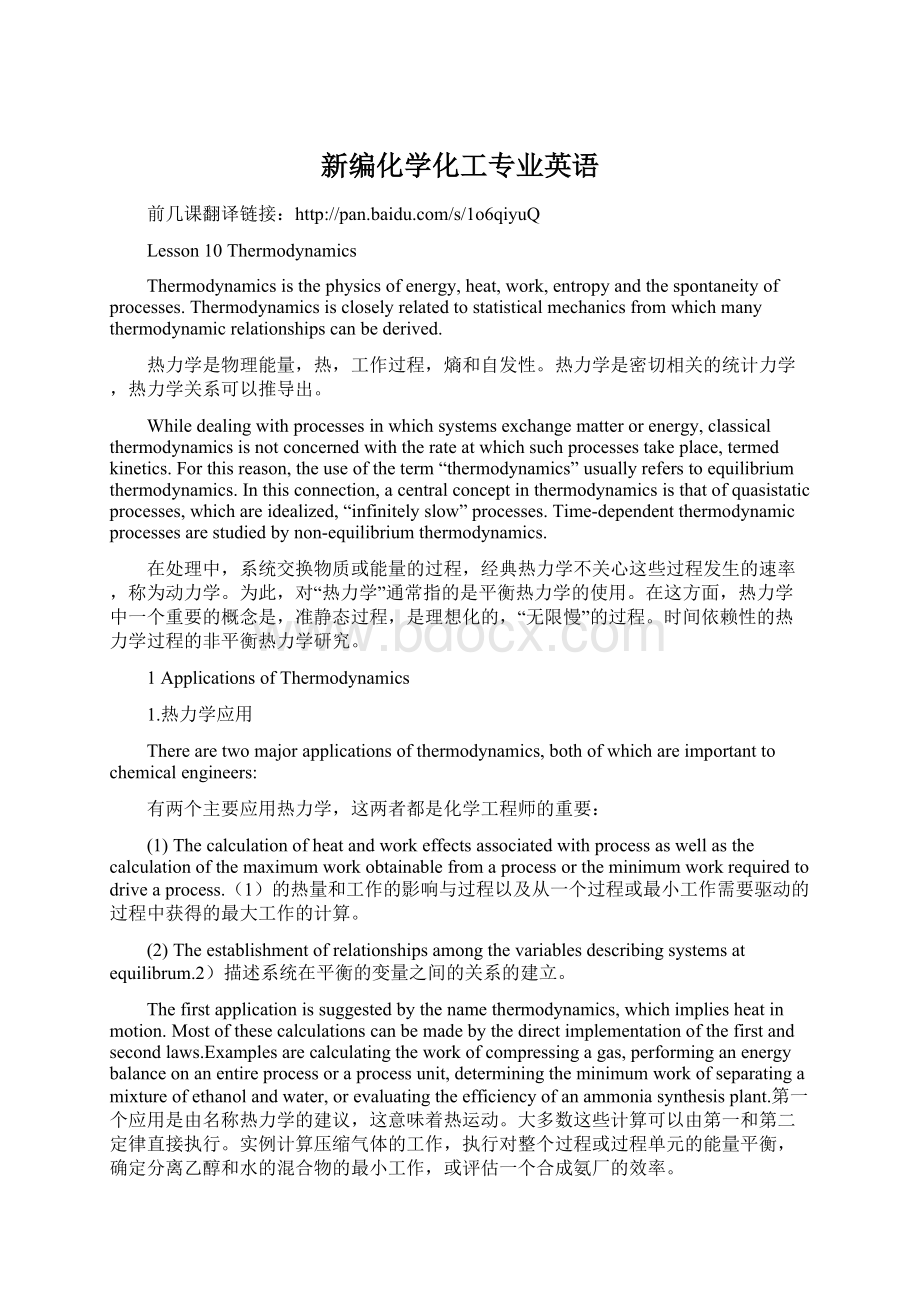 新编化学化工专业英语.docx
新编化学化工专业英语.docx
- 文档编号:5484097
- 上传时间:2022-12-17
- 格式:DOCX
- 页数:29
- 大小:51.81KB
新编化学化工专业英语.docx
《新编化学化工专业英语.docx》由会员分享,可在线阅读,更多相关《新编化学化工专业英语.docx(29页珍藏版)》请在冰豆网上搜索。

新编化学化工专业英语
前几课翻译链接:
Lesson10Thermodynamics
Thermodynamicsisthephysicsofenergy,heat,work,entropyandthespontaneityofprocesses.Thermodynamicsiscloselyrelatedtostatisticalmechanicsfromwhichmanythermodynamicrelationshipscanbederived.
热力学是物理能量,热,工作过程,熵和自发性。
热力学是密切相关的统计力学,热力学关系可以推导出。
Whiledealingwithprocessesinwhichsystemsexchangematterorenergy,classicalthermodynamicsisnotconcernedwiththerateatwhichsuchprocessestakeplace,termedkinetics.Forthisreason,theuseoftheterm“thermodynamics”usuallyreferstoequilibriumthermodynamics.Inthisconnection,acentralconceptinthermodynamicsisthatofquasistaticprocesses,whichareidealized,“infinitelyslow”processes.Time-dependentthermodynamicprocessesarestudiedbynon-equilibriumthermodynamics.
在处理中,系统交换物质或能量的过程,经典热力学不关心这些过程发生的速率,称为动力学。
为此,对“热力学”通常指的是平衡热力学的使用。
在这方面,热力学中一个重要的概念是,准静态过程,是理想化的,“无限慢”的过程。
时间依赖性的热力学过程的非平衡热力学研究。
1ApplicationsofThermodynamics
1.热力学应用
Therearetwomajorapplicationsofthermodynamics,bothofwhichareimportanttochemicalengineers:
有两个主要应用热力学,这两者都是化学工程师的重要:
(1)Thecalculationofheatandworkeffectsassociatedwithprocessaswellasthecalculationofthemaximumworkobtainablefromaprocessortheminimumworkrequiredtodriveaprocess.
(1)的热量和工作的影响与过程以及从一个过程或最小工作需要驱动的过程中获得的最大工作的计算。
(2)Theestablishmentofrelationshipsamongthevariablesdescribingsystemsatequilibrum.2)描述系统在平衡的变量之间的关系的建立。
Thefirstapplicationissuggestedbythenamethermodynamics,whichimpliesheatinmotion.Mostofthesecalculationscanbemadebythedirectimplementationofthefirstandsecondlaws.Examplesarecalculatingtheworkofcompressingagas,performinganenergybalanceonanentireprocessoraprocessunit,determiningtheminimumworkofseparatingamixtureofethanolandwater,orevaluatingtheefficiencyofanammoniasynthesisplant.第一个应用是由名称热力学的建议,这意味着热运动。
大多数这些计算可以由第一和第二定律直接执行。
实例计算压缩气体的工作,执行对整个过程或过程单元的能量平衡,确定分离乙醇和水的混合物的最小工作,或评估一个合成氨厂的效率。
Theapplicationofthermodynamicstoaparticularsystemresultsinthedefinitionofusefulpropertiesandtheestablishmentofanetworkofrelationshipsamongthepropertiesandothervariablessuchaspressure,temperature,volume,andmolfraction.Actually,application1wouldnotbepossibleunlessameansexistedforevaluatingthenecessarythermodynamicspropertychangesrequiredinimplementingthefirstandsecondlaws.Thepropertychangesarecalculatedfromexperimentallydetermineddataviatheestablishednetworkofrelationships.Additionally,thenetworkofrelationshipsamongthevariablesofasystemallowsthecalculationofvaluesofvariableswhichareeitherunknownordifficulttodetermineexperimentallyfromvariableswhichareeitheravailableoreasiertomeasure.Forexample,theheatofvaporizingaliquidcanbecalculatedfrommeasurementsofthevaporpressureatseveraltemperaturesandthedensitiesoftheliquidandvaporphaseatseveraltemperatures,andthemaximumconversionobtainableinachemicalreactionatanytemperaturecanbecalculatedfromcalorimetricmeasurementsperformedontheindividualsubstancesparticipatinginthereaction.
热力学的有用的特性,和其他变量,如压力,温度,体积性质之间的关系,建立一个网络的定义,一个特定的系统中,与摩尔分数。
实际上,应用1将不可能存在除非手段评估必要的热力学性质的变化在执行第一和第二定律。
属性的变化计算从实验确定的数据通过网络关系的建立。
此外,一个系统的变量之间的关系的网络允许是未知的或难以确定实验中是可用的或容易衡量的变量的变量值的计算。
例如,蒸发液体可从蒸汽压力测量在不同温度下的液体和蒸气相的密度在几个温度下计算出的热,在任何温度下化学反应得到最大的转换可以从热测量对个体物质参与的反应进行了计算。
2ThenatureofThermodynamics2热力学性质
A.Thermodynamicsisasciencethatincludesthestudyofenergytransformationsandoftherelationshipsamongthephysicalpropertiesofsubstancesthatareaffectedbythesetransformations.A.热力学是一门科学,包括研究的能量转换和之间的关系,通过这些变革影响物质的物理性质之间的。
1.Definitionisbroadandvague.1定义是广泛的,模糊的。
2.Mechanicalengineerstypicallyfocusonpowerandrefrigerationdevicessuchassteampowerplants,fuelcells,nuclearreactors,etc.
2机械工程师通常集中在发电和制冷设备如蒸汽发电厂,燃料电池,核反应堆等。
3.Chemicalengineerstypicallyfocusonphaseequilibriaandchemicalreactionsandtheassociatedproperties.3化学工程师通常集中在相平衡和化学反应和相关的性能。
4.Elementwhichreallysetsthermodynamicsapartfromothersciencesisthestudyofenergytransformationsthroughheatandwork.4元素,真正使热力学与其他科学是通过热与功转换能量的研究。
B.Thermodynamicpropertiescanbestudiedeitherbystudyingmacroscopicormicroscopicbehaviorofmatter.B.热力学性质进行研究无论是通过研究宏观或微观物质的行为。
1.Classicalthermodynamicstreatsmatterasacontinuumandstudiesthemacroscopicbehaviorofmatter1经典热力学治疗物质作为一个连续体,研究物质的宏观行为2.Statisticalthermodynamicsstudiesthestatisticalbehavioroflargegroupsofindividualparticles.Itpostulatesthatobservedphysicalpropertybehavior(e.g.,T,p,H,∙∙∙)isequaltotheappropriatestatisticalaverageofalargenumberofparticles.2统计热力学研究的大组的单个粒子的统计行为。
它假设,观察到的物理属性的行为(例如,T,P,H,∙∙∙)等于相应的统计平均的大量粒子。
C.Thermodynamicsisbaseduponexperimentalobservation.C.热力学是基于实验观察。
1.Conclusionsofobservationshavebeencastaspostulatesorlaws.1已被称为假设或法律结论的观察。
2.Ourstudyofthermodynamicswillconsiderfivelawsorpostulates;twodealingwithenergytransformationandthreedealingwithproperties.2我们的热力学研究会考虑五法律或假设;两个处理的能量转换和三处理性能。
EnergyTransformationLaws:
能量转化规律:
a.FirstLawofThermodynamics--Energyisconserved.(Youcan'twin!
)
A.热力学第一定律——能量守恒。
(你不可能赢的!
)
b.SecondLawofThermodynamics--Takesmanyforms.Inessenceitsaysthatenergyhasdifferent“quality”andprocessesonlyspontaneouslyproceedinonedirection.Itisn'tpossibletoconvertalloftheenergyofasystemintowork.
B.热力学第二定律——以多种形式。
从本质上说,能有不同的“质量”,只在一个方向自发进行的过程。
你不可能将所有的精力投入到工作的系统。
PropertyRelationshipLaws:
c.ZerothLawofThermodynamics--Wheneachoftwosystemsisinthermalequilibriumwithathirdsystem,theyarealsointhermalequilibriumwitheachother.
C.热力学第零定律——当两个系统都是在热平衡三分之一系统,他们也彼此处于热平衡状态。
d.ThirdLawofThermodynamics--The“entropy”ofaperfectcrystaliszeroatabsolutezerotemperature
.D.热力学第三定律——“熵”的一个完美的晶体是零在绝对零度的温度下。
e.StatePostulate--Thestateofasimple,singlephasethermodynamicsystemiscompletelyspecifiedbytwoindependentlyvariable,intensiveproperties.
E状态的假设——一个简单的状态,单相的热力学系统完全由两个独立的变量指定的,密集的性质。
D.EnergyConversionandEfficiency
能量转换效率
1.Aprimaryconcerninthermodynamicsisenergyconversionandameasureofenergyconversionsuccessiscalledtheefficiency.Forenergyconsumingorproducingdevicesitiscalledthethermalefficiency:
1热力学中的一个主要关注的是能源转换和衡量成功的被称为能量转换效率。
对能源的消耗及生产设备,它被称为热效率:
3DefinitionsandThermodynamicVocabulary
3定义和热力学的词汇
A.ThermodynamicSystem
A.热力系统
1.Definition--Athreedimensionalregionofspaceboundedbyarbitrarysurfaces(whichmayberealorimaginaryandmaychangesizeorshape)whichdelineatetheportionoftheuniverseweareinterestedin.
1定义——一三维空间区域范围内的任意曲面(这可能是真实的或想象的,可能会改变大小或形状),勾画出我们感兴趣的是宇宙的一部分。
a.ClosedSystemisasystemthatisclosedwithrespecttotheflowofmatter,e.g.,fixed,closedvolume.Aclosedsystemisdefinedbyafixedquantityofmass.
封闭的系统是一个系统,是相对于物质流,例如,固定的闭合,闭合容积。
一个封闭的系统是由一个固定数量的质量定义。
b.OpenSystemisasystemthatisopenwithrespecttotheflowofmattersuchasacompressor.Thesystemisdefinedbyanimaginaryvolumesurroundingtheregionofinterest.Thesurfaceofthisvolumeiscalledthecontrolorsigma(s)surface.Mass,heat,workandmomentumcanflowacrossthecontrolsurface.
打开系统是一个系统,是相对于物质如压缩机流量开放。
该系统是由周围感兴趣区域的一个假想的体积定义。
本卷的表面被称为控制或σ(的)表面。
质量,动量和热量,工作可以流过控制面。
c.IsolatedSystemisasystemthatisnotinfluencedinanywaybythepartofspacewhichisexternaltothesystemboundaries.Noheat,work,massormomentumcancrosstheboundaryofanisolatedsystem.(N,V,U)arefixedandconstantinaclosedsystem.
C.孤立系统是一个系统,不影响任何方式的空间是系统边界外的部分。
没有热,质量和动量的工作,可以跨一个孤立的系统边界。
(N,V,U)是固定的,在一个封闭的系统常数。
d.SimpleSystemisasystemthatdoesnotcontainanyinternaladiabatic,rigidandimpermeableboundariesandisnotacteduponbyexternalforces.
D.简单的系统是一个系统,不包含任何内部绝热,刚性和不透水边界并不是由外力驱动。
e.CompositeSystemisasystemthatiscomposedoftwoormoresimplesystems.
E.复合系统是一个系统,由两个或两个以上的简单系统。
B.Property
B.属性
1.Definition--Acharacteristicofasystem.
1定义一个系统的一个特性—。
a.PrimitivePropertyisapropertythatcaninprinciplebespecifiedbydescribinganoperationortesttowhichthesystemissubjected.Examplesincludemechanicalmeasurements(e.g.,pressure,volume,andthermometrictemperatureT)andheatcapacity.
原始的财产是财产,原则上可以在指定的描述一个操作或测试该系统受到。
例子包括机械测量(例如,压力,体积和温度,温度T)和热容量。
b.DerivedPropertyisapropertythatismathematicallydefinedintermsofprimitiveproperties.
B.派生属性,是数学中的原始定义属性的属性。
c.IntensivePropertyisapropertythatisindependentoftheextentoformassofthesystem.ExamplesareT,P,density,(x),etc.
C.密集的属性是独立的程度,或系统的质量属性。
的例子是T,P,密度,(x),等。
d.ExtensivePropertyisapropertywhosevalueforthesystemisdependentuponthemassorextentofthesystem.Examplesaretheenthalpy,internalenergy,volume,etc.
D.广泛性是系统的值是依赖于系统的质量或程度的财产的例子是内部的能量,焓,体积,等。
e.SpecificPropertyisanextensivepropertyperunitmass.Specificpropertiesareintensive.
E.特性是一个广泛的每单位质量特性。
具体性能密集型。
f.StatePropertyisapropertythatonlydependsonthethermodynamicstateofthesystem,notthepathtakentogettothatstate.
F.国家财产是财产,仅取决于系统的热力学状态,而不是采取的路径到达这一状态。
C.StateofaSystem
C.系统状态
1.ThermodynamicState--Theconditionofthesystemascharacterizedbythevaluesofitsproperties.
1热力学状态——系统的状况为特征的自身属性的值。
2.StableEquilibriumStateisastateinwhichthesystemisnotcapableoffinitespontaneouschangetoanotherstatewithoutafinitechangeinthestateofthesurroundings.
2稳定平衡状态是不能够有限自然变化到另一种状态是系统的状态不在周围的区域有限的改变。
a.Manytypesofequilibriummustbefulfilled--thermal,mechanical,phase(material)andchemical.
许多类型的平衡必须满足——热,机械,化学和相位(材料)。
3.StatePostulate:
Theequilibriumsta
- 配套讲稿:
如PPT文件的首页显示word图标,表示该PPT已包含配套word讲稿。双击word图标可打开word文档。
- 特殊限制:
部分文档作品中含有的国旗、国徽等图片,仅作为作品整体效果示例展示,禁止商用。设计者仅对作品中独创性部分享有著作权。
- 关 键 词:
- 新编 化学 化工 专业 英语
 冰豆网所有资源均是用户自行上传分享,仅供网友学习交流,未经上传用户书面授权,请勿作他用。
冰豆网所有资源均是用户自行上传分享,仅供网友学习交流,未经上传用户书面授权,请勿作他用。


 转基因粮食的危害资料摘编Word下载.docx
转基因粮食的危害资料摘编Word下载.docx
